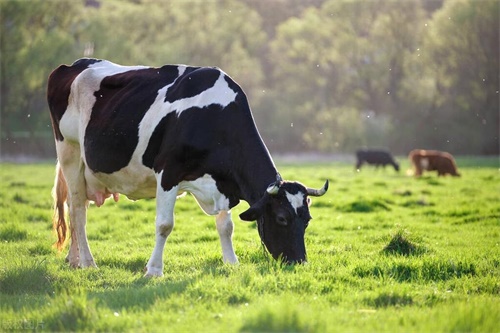When cows come out of calving, their reproductive cycle doesn’t immediately bounce back to normal. In fact, the ovaries of postpartum cows often behave quite differently from what you’d see in a cycling cow. One of the key features during this phase, which is medically called postpartum anestrus, is that the ovary becomes dominated by small follicles instead of the usual pattern of dominant follicle growth and ovulation. This phenomenon has significant implications for fertility management on farms, and understanding it better can help farmers and vets optimize reproductive strategies.

What’s Going on in the Ovary After Calving?
Right after calving, cows enter a period known as postpartum anestrus, where the normal estrous cycles pause or become irregular. It’s a natural response as the body recovers from pregnancy and birth. During this time, the hormonal environment changes dramatically: levels of luteinizing hormone (LH) and follicle-stimulating hormone (FSH) shift, often resulting in insufficient stimulation for dominant follicle growth and ovulation.
What you mostly see instead are lots of small follicles—essentially immature ovarian follicles that don’t progress far enough to trigger ovulation. These small follicles tend to accumulate, leading to a state where the ovary appears to be ‘stuck’ in this immature follicular phase.
Why Does Small Follicle Dominance Matter?
The dominance of small follicles signals that the cow’s reproductive system hasn’t fully ‘woken up’ yet. Since no dominant follicle reaches maturity, no ovulation occurs, and the cow doesn’t come into heat. This leads to delays in returning to fertility, which obviously impacts breeding schedules, conception rates, and ultimately the farm’s profitability.
In practical terms, this means:
AI (artificial insemination) can’t be effectively timed without proper estrus signs.
Hormonal treatments might be needed to stimulate follicle growth.
Farmers need to carefully monitor cows postpartum to catch when their cycles resume.
How Does Follicular Development Normally Work?
In cycling cows, the ovary goes through waves of follicle development, where small follicles grow, but only one or sometimes two follicles become dominant. This dominant follicle grows large enough to produce sufficient estradiol, which then triggers a cascade of hormonal changes leading to ovulation.
Follicle growth is regulated by a delicate balance of hormones:
FSH stimulates early follicle growth.
LH surge triggers ovulation of the dominant follicle.
Estradiol produced by the dominant follicle feeds back to the brain to regulate these hormones.
In postpartum anestrus cows, this cycle is disrupted, and follicles often stall at the small stage due to inadequate LH support and other hormonal imbalances.
What Causes the Small Follicle Dominance in Postpartum Anestrus?
Several factors contribute:
1. Hormonal Changes
The postpartum period comes with lower LH pulse frequency and amplitude, which is critical for follicle maturation. While FSH may be sufficient to initiate follicle growth, without enough LH pulses, the follicles fail to develop beyond the small size.
2. Negative Energy Balance (NEB)
After calving, many cows experience a negative energy balance because their energy output for milk production exceeds intake. This metabolic stress impacts reproductive hormones and delays follicular development.
3. Uterine Health
Inflammation or infections in the uterus postpartum can also negatively affect ovarian function, further delaying follicle maturation.
How Can We Detect This Small Follicle Dominance?
One of the most reliable ways is through ultrasound scanning of the ovaries. Ultrasound allows vets or trained farm workers to visualize follicles and identify their size and number.
A typical postpartum anestrus ovary will show:
Multiple small follicles (usually less than 5 mm in diameter).
Absence of a dominant follicle (usually >8-10 mm).
Lack of corpus luteum (signifying no recent ovulation).
Using ultrasound regularly during the first weeks postpartum can help pinpoint when the cow is moving out of anestrus and ready to breed.
What Does This Mean for Fertility Management?
Since small follicle dominance means no ovulation, the primary goal is to stimulate the cow’s ovary to resume normal follicle growth and ovulation. Some approaches include:
Hormonal Protocols
Administering hormones like GnRH or prostaglandins can help induce ovulation or synchronize follicle waves to improve breeding timing.
Nutrition Management
Ensuring cows have adequate energy intake postpartum helps minimize negative energy balance and supports reproductive hormone recovery.
Health Monitoring
Treating uterine infections promptly and maintaining good postpartum health reduces ovarian dysfunction.
Follicle Size and Reproductive Outcome
Studies have shown that cows with persistent small follicle dominance often have reduced conception rates. For instance, small follicles are less capable of producing enough estradiol, which is essential for triggering behavioral estrus and ovulation. Moreover, follicles that fail to mature properly often result in poor oocyte quality, lowering embryo viability.
How Do Foreign Experts View This?
Veterinary and reproductive specialists internationally recognize small follicle dominance as a key challenge in postpartum cow fertility. In countries with intensive dairy industries, like the US, New Zealand, and parts of Europe, there’s a strong emphasis on early postpartum monitoring and intervention to reduce the duration of anestrus.
Experts highlight that understanding the physiology of follicle development postpartum is crucial for designing effective reproductive management programs. They encourage the use of ultrasonography as a standard tool on farms for early detection of ovarian status and to guide treatments.
Practical Takeaways for Farmers
Start ovarian ultrasound monitoring as early as 2 weeks postpartum to track follicle development.
Pay close attention to cows showing prolonged absence of dominant follicles.
Work with vets to develop hormone-based protocols tailored to your herd’s health and nutritional status.
Optimize feeding strategies to reduce negative energy balance and support reproductive recovery.
Treat uterine infections aggressively and maintain good herd hygiene.
Follicle Size Categories and Their Reproductive Implications
| Follicle Size (mm) | Description | Reproductive Implication |
|---|---|---|
| 1-5 | Small Follicles | Common in postpartum anestrus; no dominant follicle, no ovulation |
| 6-8 | Medium Follicles | Follicles may become dominant if hormonal support increases |
| 8-10 | Dominant Follicle | Ready for ovulation; estradiol production triggers heat behavior |
| 10-12 | Immature follicles | |
| 12-20 | mature follicles |
Closing Thoughts
Dealing with postpartum anestrus is a common but tricky part of managing a dairy or beef herd. The fact that the ovary is often dominated by small follicles during this time can be frustrating, but it also opens up an opportunity. With the right tools—especially ultrasound imaging—and a solid understanding of the underlying biology, farmers and vets can work together to reduce anestrus length, improve reproductive efficiency, and ultimately boost farm profitability.
The key is not to ignore the subtle signs. Early detection and intervention can make a big difference, and as technology becomes more affordable and accessible, more farms worldwide will adopt these methods as part of their routine reproductive management.
tags: Cow Follicle Development


